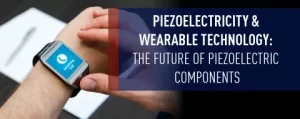Jump To: What Is Wearable tech | Energy Harvesting | Energy Harvesting Today | Energy Harvesting With Tech | Piezo Energy Harvesting | Sensor Applications

With the vast amount of wearable technology available, the demand for compact devices with smaller batteries, or no batteries at all, and longer charge duration has presented a challenge. Consumers of wearable technology want the convenience of a portable device without the need for frequent charging or bulky and expensive batteries. Producers of wearable technology are then tasked with creating devices that meet this demand. The use of piezoelectric components in wearable technology is an emerging solution for this issue.
The science behind piezoelectricity states that certain materials will produce an electrical charge when force or pressure is applied. The direct piezoelectric effect is the process through which an electrical charge is produced as a result of an applied stress, mechanical, thermal or other. The converse piezoelectric effect is the dimensional change that results from an applied electrical field. One potential use for this technology is to allow wearable devices to be charged from body movement, pressure or other external forces.
Bulk piezoelectric components are polycrystalline ceramic components containing metal oxides. They can be produced on a small or large scale and manipulated into many different shapes and forms. They are also relatively inexpensive to produce.
Piezoelectricity is a green form of energy since it harvests electricity from ambient sources. Its use stands to reduce, or even eliminate, the need for frequent charging of devices and batteries. Consumers will no longer be burdened with having to be near an electrical outlet, which will in turn conserve electricity. As a result, wearable devices and more efficient batteries will have longer usable lives. This will also reduce the environmental hazards presented by the frequent disposal of batteries and electrical components into landfills.
Wearable technology is any electronic device or computer that is built into clothing or compact accessories and can be worn on or incorporated into the body. Many of these devices collect and communicate information wirelessly through apps or the devices themselves.
Wearable devices include:
Their small size, portability and ability to perform a variety of functions make wearable devices extremely popular with consumers. The wearable device market is not one that will be waning anytime soon. In fact, it is estimated that almost 215 million wearable devices will be sold and shipped by 2019.

Energy harvesting is a process that takes an otherwise wasted energy source and converts it into electrical energy. The energy can then be stored in capacitors or batteries and used to supply power. Ambient energy can be harnessed from the environment around us.
Methods of energy harvesting include:
– Electromagnetic emissions: Energy is harvested from radio frequencies and signals such as Wi-Fi and Bluetooth.
– Kinetic: Energy is harvested by movement or friction. Devices will have the ability to be charged and powered just by user movement.
– Solar cell: Energy is harvested from the sun. In the past, this form of energy harvesting has been used in watches as well as other small wearable devices. One of the main issues with this kind of energy harvesting is that the device must be constantly exposed to the light to continue charging. A solution to this is a fabric that has cells woven into it and is designed to harvest energy from both solar and indoor light.
– Thermoelectric: This type of energy harvesting converts heat into electric energy. Potential uses include cells that use human body heat to produce energy. One advantage of this type of energy harvesting is that it can be used at all times of day.
– Piezoelectric: This type of energy harvesting converts mechanical energy from vibrations or shocks into electrical energy.
Once the energy source is present, there are three other factors that must be present to complete an energy harvesting system:
1. A device that can convert an energy source into electrical energy
2. A module that can harvest, store and control that electrical energy
3. A wireless sensor network or other monitoring device
Piezo energy harvesting only creates small amounts of energy, but the ability to store it to eliminate the need for, or to prolong the life of, supplemental batteries is promising.

Energy harvesting has been around since the days when solar power, water and wind were used to generate electricity for factories, farms and homes. While still used in many of the same applications today, the primary goal of energy harvesting now is to eliminate dependence on batteries in electrical devices.
Energy harvesting can be seen in current products such as toys, satellites, watches, calculators and streetlights. The ability to collect and store ambient energy from motions, radio frequencies and other environmental sources is an encouraging step toward global energy conservation. Its use in new technologies, particularly in wearable devices, presents an exciting new set of prospective applications. In fact, the energy harvesting industry is expected to reach $2.6 billion by 2024.
Energy harvesting has the potential to forever change the way wearable technology is used. Wearable devices would essentially be self-charging and self-powering. Consumers would be able to use devices with little to no need for batteries or electricity to charge.
The desire for wearable devices to be inexpensive, compact and powerful has pushed their producers to explore different methods of energy harvesting. Of all the methods available, three are always being evaluated for use with wearable devices: solar, thermoelectric and piezoelectric.
While all three energy methods show potential for use with wearable devices, each has their own advantages and limitations. The issue is not so much with creating enough energy to power the device, but more with the energy draw created by the constant connectivity with Bluetooth, Wi-Fi and other wireless signals. While current energy harvesting methods have proven effective in extending rather than totally eliminating batteries from wearable devices, research continues to bring the ultimate goal of complete battery replacement closer to fruition.
Solar energy harvesting involves the use of small solar cells that require direct sunlight to maintain their optimum power output. Their compact size makes solar cells a good option with wearable devices – but most people do not have access to the amount of direct sunlight needed to efficiently power them.
Thermoelectric energy harvesting involves using human body heat. While this is an unlimited resource, it is difficult to maintain the temperature differential needed to power the system without increasing the size of the required energy harvesting components.

Harvesting energy using piezoelectric ceramic involves the conversion of energy from vibrations that occur during walking, breathing and moving. When stressed, piezoelectric components create an electrical current that can be immediately used or stored.
Research is ongoing into the practicality of piezoelectric energy harvesting in wearable devices. The amount of energy produced is still relatively small, and required body movements aren’t often regular and predictable. Also, a large surface area is often necessary to harvest a sufficient amount of energy. This presents a challenge when thinking of the small size needed in wearable devices.
Two promising factors in surmounting these obstacles are the versatility of piezoelectric components and the fact that the efficiency of piezoelectric energy harvesting has increased, while the power requirements for current wearable devices have been reduced.
There are four different types of materials that can be used for piezoelectric energy harvesting: ceramics, single crystals, polymers and composites. Of these, ceramic is the preferred material for this type of energy harvesting because of its low cost, effective piezoelectric properties and easy incorporation into energy harvesting devices.
Piezoelectric materials and components each have their own properties that result in the production of or utilization of different electrical and mechanical frequencies. These include their reactions to vibration and other mechanical stress, their shape, their design and their chemical makeup.
Piezoelectric vibration energy harvesting is the preferred method for use with wearable devices since it is the most capable of producing the power level needed for small-scale devices.
Piezoelectric energy harvesting components can be seen in both existing and developing products such as:
Piezoelectric sensors are devices that create an electrical signal when acted upon by a physical force (pressure, acceleration, vibration, etc.). This signal can serve as a monitor or sometimes as the creator of the electrical signal itself. The signal is then routed to a data processing system. In some cases, the sensor technology itself can be utilized to harvest energy when it is not actively sensing.
Types of piezoelectric sensors include:
– Accelerometers: Sensors that can measure vibration and adjust the inner workings of machines accordingly
– Flow sensors: Sensors that monitor and regulate the flow rate of liquids
– Level sensors: Sensors that detect how much material is in a container
Piezoelectric sensors are currently in use across many applications and industries. Their low power demand and portability make their use in piezoelectric sensor networks an affordable and efficient option. Here’s a look at where you can find the piezoelectric sensors.
In the automotive industry:
In the commercial industry:
In the fitness & medical industries:
Personal Applications:

Piezoelectric components can be used for wearable technologies and other new technologies. Their use presents vast possibilities across many industries. Human comfort, convenience, health and safety have the potential to be greatly improved with the availability and use of products containing piezoelectric components. Many of these capabilities and products are already emerging in today’s society.
These include:
– A piezoelectric pacemaker that is powered by the rhythm of a beating heart. This eliminates the need for invasive and dangerous surgery for battery replacement
– Footpath lighting powered by footsteps striking energy-absorbing tiles
– The ability to power monitoring and sensor devices in remote and dangerous places (bridges, pipelines, etc.). This eliminates the risk to humans that arises when batteries need charging or replacing
– A vehicle driver’s seat that uses piezoelectric sensors to monitor and sense driver’s heart rate and respiration. It uses vibration sensors to allow ventilation and massage features to be automatically activated in the seat when driver stress is detected
– Wearable devices that can be charged by walking, running or other physical activity
Some wearable sensors on the market today include fitness and activity wristbands and monitors that observe distance, respiration, heart rate and even sleep patterns. Wireless blood pressure cuffs measure patient’s blood pressure through a phone app. Quartz watches have been around for a long time and employ the natural piezoelectric property of quartz to keep precise time. Monitors that detect and measure fetal heartbeats use piezoelectric components to convert the vibration into a readable signal.
The use of “smart” fabrics is also gaining popularity. The flexible fabrics are infused with piezoelectric materials that act as sensors to measure, monitor and harvest energy. A single pressure-sensitive layer is sandwiched between two conductive layers. These sensors are currently being developed for use as shoe insoles, clothing and wearable devices that measure information such as pressure, steps, energy expended, etc. The amount of energy created by the fabrics differs with factors such as the type of piezo material used and the movement of the user.
Piezoelectric components for wearables are ideal due to their flexibility, relatively low cost and compact size. They can also be manufactured in all shapes and sizes and in different forms. The versatility of piezoelectric components offers users a wide variety of options for use with their piezoelectric projects. The different piezo materials available each have their own unique properties that can be designed and adapted for different needs and uses.
While still in the developing stages, the use of piezoelectric components as energy harvesters in wearable technology has already proven to be a feasible option in decreasing their size while maintaining battery life.
APC International supplies PZT based piezoelectric ceramic materials to a wide range of different customers. We manufacture custom piezoelectric ceramics and devices in a variety of different shapes, sizes and forms. We value our customers and offer competitive pricing with a one-week delivery time for in-stock items. Please contact a member of our team for more information about our in stock and custom piezo products or request a quote to discuss your custom needs.
Top Uses of Piezoelectricity in Everyday Applications
Piezo Buzzers vs. Magnetic Buzzers
Principles of Piezoelectric Energy Harvesting